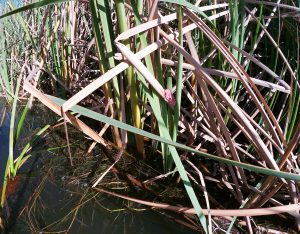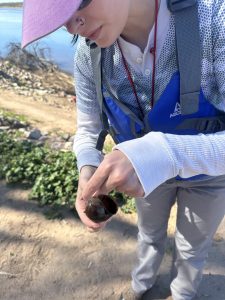- Slug: BC-CNS-Invasive Snails. 720 words.
- 6 photos available (thumbnails and captions below).
- Videos available here and here.
By Sarah Min Heller
Cronkite News
MESA – Arizona Game and Fish wants to rid the state of an invasive gastropod pest, and it’s counting on responsible pet owners, outdoor enthusiasts, citizen scientists and volunteers to help.
Apple snails probably came to Arizona through the aquarium pet trade and started causing havoc when they were released into the wild, introducing pathogens and parasites and threatening native species.
“These particular snails are somebody’s unwanted aquarium pet, which has been a real problem,” said Jeff Sorensen, invertebrate wildlife program manager for the Arizona Game and Fish Department, who said releasing this snail into the state’s waterways has had “disastrous results.”
The apple snail – which grows to 6 inches, or about the size of an apple – is originally from South America. It was identified as an invasive species in Arizona in 2011. Sorensen continues to research ways to eradicate it and shares this with volunteers who help knock down the clusters of bright pink snail eggs this time of year.
Apple snails feed on local vegetation and the juveniles of native snail species. And the invasive snails have a built-in advantage, because native predators won’t eat the foul-tasting snails, Sorensen said.
Apple snails were sold as mystery snails in pet shops, but since 2012, it has been illegal to sell them under the Game and Fish director’s orders on aquatic invasive species.
Game and Fish works with partners such as Tonto National Forest and SeaLife to conduct surveys and it accepts volunteers who can provide their own boats and life jackets.
Sorensen and students from high school biology classes go on walking surveys along canals and urban ponds in Tempe and Scottsdale to count egg masses and observe snails in the water. Sorensen also works with Scottsdale Community College students to research the invasive species, which reproduces quickly, laying 25-500 eggs per clutch every 12 to 15 days. A single female can produce up to 15,000 eggs a year, Sorensen said.
“On these surveys for the apple snails, we kayak up and down the Salt River,” said Bryce Sutter, a lab manager at Arizona State University and former Game and Fish intern who volunteers with Sorensen. “We do a timed count – a catch per unit. We basically look for these pink egg masses. We use these clickers to count the egg masses we find.”
Egg masses are mostly seen from late March to September, so if people spot one of the bubble-gum-pink egg masses, they can knock the masses into the water or spray cooking oil on them, Sorensen said.
“We do hear folks saying ‘Oh, yeah, I know about those things,’” Sorensen said. “Knock those egg masses down. The more folks that can help us with that, then perhaps maybe we can get a control on these guys.”
When encountering a snail, people can collect it, put it in a trash bag and throw it in a dumpster, Sorensen said. However, people should wash their hands if they have touched an apple snail, because the snail can carry a nematode that might cause rat lungworm disease, which could cause eosinophilic meningitis in humans, according to the Centers for Disease Control and Prevention.
Arizonans who don’t want their pet apple snails are advised to euthanize them by putting them in a plastic bag and placing them in the freezer, letting them die and then throwing them into the garbage.
“Unwanted pets don’t belong in the wild,” Sorensen said. “If you release it out into the wild, it’s going to cause all sorts of impacts. We’re introducing pathogens, parasites and a very hungry and very competitive snail.”
While their population has stayed about the same since the department started working to eradicate the snails in 2012, Sorensen said the population has been documented up the lower Salt River in the past decade from Granite Reef Recreational Area in Mesa to Blue Point Recreation Area in Fort McDowell. The department is trying to determine if the population migrated or if it is a new population from released pets.
“Now we have these in a lot of our urban lakes, community fishing waters and some of the canals all throughout the Phoenix area,” Sorensen said, adding that the snails have been seen in other bodies of water documented by Arizona Game and Fish.
“Help us try to knock their numbers down,” Sorensen said.
For more stories from Cronkite News, visit cronkitenews.azpbs.org.




